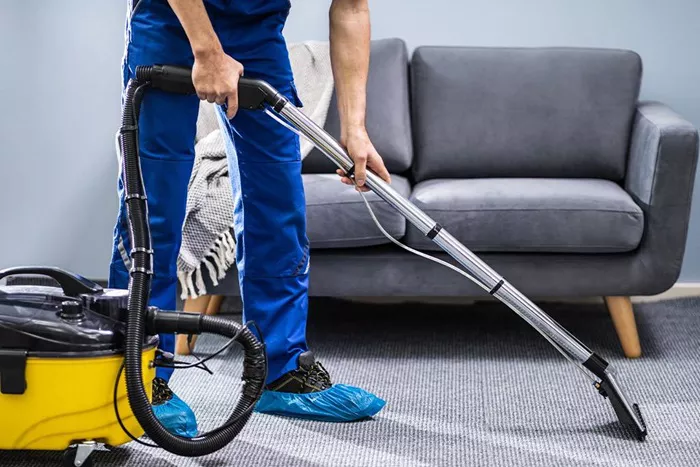An AI robot vacuum is a smart cleaning device designed to automatically clean floors without much human help. It uses artificial intelligence (AI) to navigate, detect dirt, and avoid obstacles in your home. These vacuums are small, round machines that move on their own and clean surfaces such as carpets, hardwood, and tiles.
With the rise of smart home technology, AI robot vacuums have become popular for their convenience and efficiency. They save time and effort by doing regular cleaning tasks on their own.
How Does an AI Robot Vacuum Work?
Basic Components
An AI robot vacuum typically has these parts:
- Sensors: Detect obstacles, cliffs (like stairs), and dirt.
- Motors: Move the vacuum and spin the brushes.
- Brushes and Suction: Sweep and suck up dust and debris.
- Battery: Powers the vacuum for cleaning sessions.
- AI Chip and Software: Control navigation and cleaning patterns.
Navigation and Mapping
AI robot vacuums use various navigation methods to clean efficiently:
- Infrared and Ultrasonic Sensors: Detect objects and walls.
- Laser Distance Sensors (LIDAR): Create a map of the room for planned cleaning.
- Camera-Based Navigation: Recognize furniture and obstacles visually.
These technologies help the vacuum avoid bumping into furniture, falling down stairs, or getting stuck. More advanced models build a detailed map of your home to clean in a systematic way.
Cleaning Modes
AI robot vacuums often have different cleaning modes, such as:
- Spot Cleaning: Focuses on a small, dirty area.
- Edge Cleaning: Cleans along walls and corners.
- Automatic Cleaning: Covers the entire mapped area systematically.
Benefits of AI Robot Vacuums
Time-Saving
Robot vacuums clean your floors automatically. You can set schedules and let the vacuum work while you focus on other tasks.
Consistent Cleaning
Because they clean regularly, AI robot vacuums help keep your home consistently tidy, reducing dust and allergens.
Smart Features
Many models connect to your smartphone through apps. You can start, stop, or schedule cleaning from anywhere. Some even respond to voice commands via smart assistants like Alexa or Google Assistant.
Limitations of AI Robot Vacuums
Battery Life
Most robot vacuums run for about 60 to 120 minutes on a single charge. Large homes may require multiple charges or sessions to finish cleaning.
Cleaning Power Compared to Traditional Vacuums
While convenient, robot vacuums usually have less suction power than upright or canister vacuums. They may not deep clean thick carpets as well.
Handling Complex Obstacles
Some vacuums can struggle with cluttered rooms or thick rugs. They may get stuck or miss spots without human intervention.
Types of AI Robot Vacuums
Basic Models
These offer simple cleaning with basic sensors and random movement patterns. They are affordable but less efficient.
Advanced Models with Mapping
These use LIDAR or cameras to create detailed maps and clean methodically. They can remember room layouts and improve cleaning over time.
Hybrid Models
Some AI robot vacuums also mop floors using a water tank and mop pad in addition to vacuuming. These are great for hard floor surfaces.
Vacuum Cleaner Types and AI Robot Vacuums
AI robot vacuums are a special type within the broader vacuum cleaner types. Other types include upright, canister, handheld, and stick vacuums. Each type has pros and cons depending on the cleaning task and home environment.
Common Uses of AI Robot Vacuums
AI robot vacuums are ideal for everyday cleaning of dust, pet hair, and small debris. They work well on hardwood, tile, and low-pile carpets. Many users rely on them for maintenance cleaning between deep cleans done by traditional vacuums.
How to Choose the Right AI Robot Vacuum
Consider Your Floor Type
For hardwood and tile floors, most robot vacuums work well. For thick carpets or rugs, look for models with stronger suction and brush rolls designed for deep cleaning.
Navigation and Mapping Features
If your home has many rooms or obstacles, choose a vacuum with advanced mapping and navigation to clean efficiently and avoid getting stuck.
Battery Life and Charging
Choose a model with enough battery life to cover your home. Some vacuums automatically return to their charging base and resume cleaning after recharging.
Smart Features and Controls
Decide if you want app control, voice assistant compatibility, and scheduling options for ease of use.
Maintenance Tips for AI Robot Vacuums
Regularly Empty the Dustbin
Keep the dustbin clean to maintain suction power and prevent clogs.
Clean Brushes and Filters
Remove hair and debris from brushes. Replace filters as recommended by the manufacturer.
Check Sensors and Wheels
Wipe sensors gently to keep navigation accurate. Clean wheels to avoid movement problems.
The Future of AI Robot Vacuums
AI robot vacuums continue to improve with better AI, stronger batteries, and more advanced cleaning capabilities. New models may include more powerful suction, improved mopping functions, and even better obstacle avoidance.
Integration with smart home systems is also growing, making these vacuums more user-friendly and intelligent.
Conclusion
AI robot vacuums are a convenient tool for keeping floors clean with minimal effort. They combine AI, sensors, and smart navigation to work automatically. While they may not fully replace traditional vacuums for deep cleaning, they are excellent for daily maintenance. By understanding their features and limitations, you can choose the right model to fit your home and cleaning needs.
Related topics:
- What is a Car Vacuum Cleaner: A Complete Guide
- Lefant Vacuum Cleaner: Models, Features & Maintenance Tips
- What is a Tineco Vacuum Cleaner: A Detailed Analysis

